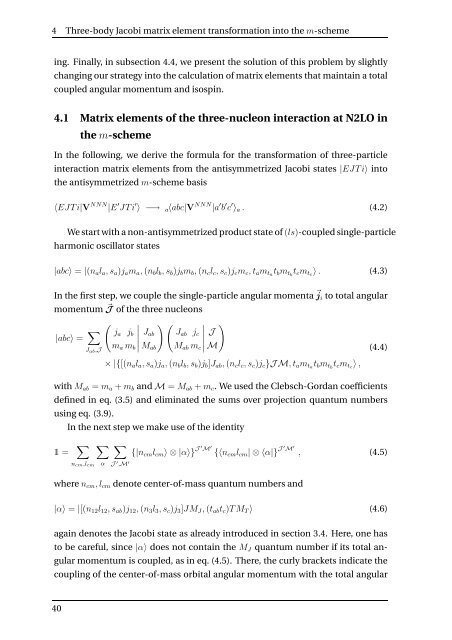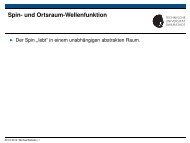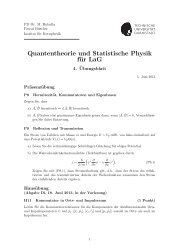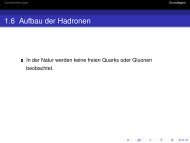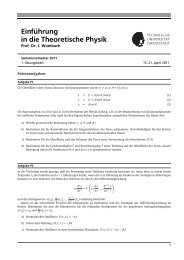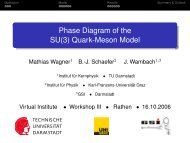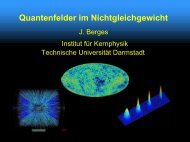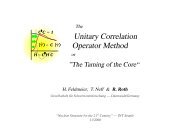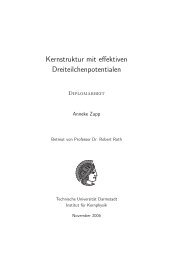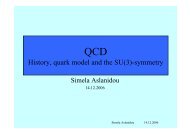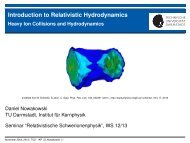Consistent chiral three-nucleon interactions in ... - Theory Center
Consistent chiral three-nucleon interactions in ... - Theory Center
Consistent chiral three-nucleon interactions in ... - Theory Center
Create successful ePaper yourself
Turn your PDF publications into a flip-book with our unique Google optimized e-Paper software.
4 Three-body Jacobi matrix element transformation <strong>in</strong>to the m-scheme<br />
<strong>in</strong>g. F<strong>in</strong>ally, <strong>in</strong> subsection 4.4, we present the solution of this problem by slightly<br />
chang<strong>in</strong>g our strategy <strong>in</strong>to the calculation of matrix elements that ma<strong>in</strong>ta<strong>in</strong> a total<br />
coupled angular momentum and isosp<strong>in</strong>.<br />
4.1 Matrix elements of the <strong>three</strong>-<strong>nucleon</strong> <strong>in</strong>teraction at N2LO <strong>in</strong><br />
the m-scheme<br />
In the follow<strong>in</strong>g, we derive the formula for the transformation of <strong>three</strong>-particle<br />
<strong>in</strong>teraction matrix elements from the antisymmetrized Jacobi states |EJTi〉 <strong>in</strong>to<br />
the antisymmetrized m-scheme basis<br />
〈EJTi|V NNN |E ′ JTi ′ 〉 −→ a〈abc|V NNN |a ′ b ′ c ′ 〉a . (4.2)<br />
We start with a non-antisymmetrized product state of (ls)-coupled s<strong>in</strong>gle-particle<br />
harmonic oscillator states<br />
|abc〉 = |(nala, sa)jama, (nblb, sb)jbmb, (nclc, sc)jcmc, tamtatbmtb tcmtc〉 . (4.3)<br />
In the first step, we couple the s<strong>in</strong>gle-particle angular momenta ji to total angular<br />
momentum J of the <strong>three</strong> <strong>nucleon</strong>s<br />
|abc〉 = <br />
<br />
<br />
<br />
ja jb Jab Jab jc J<br />
<br />
<br />
<br />
M<br />
Jab,J<br />
ma mb<br />
Mab<br />
Mab mc<br />
× |{[(nala, sa)ja, (nblb, sb)jb]Jab, (nclc, sc)jc}J M, tamtatbmtb tcmtc〉 ,<br />
(4.4)<br />
with Mab = ma + mb and M = Mab + mc. We used the Clebsch-Gordan coefficients<br />
def<strong>in</strong>ed <strong>in</strong> eq. (3.5) and elim<strong>in</strong>ated the sums over projection quantum numbers<br />
us<strong>in</strong>g eq. (3.9).<br />
In the next step we make use of the identity<br />
1 = <br />
ncm,lcm<br />
<br />
α<br />
<br />
J ′ ,M ′<br />
{|ncmlcm〉 ⊗ |α〉} J ′ M ′<br />
{〈ncmlcm| ⊗ 〈α|} J ′ M ′<br />
where ncm, lcm denote center-of-mass quantum numbers and<br />
, (4.5)<br />
|α〉 = |[(n12l12, sab)j12, (n3l3, sc)j3]JMJ, (tabtc)TMT 〉 (4.6)<br />
aga<strong>in</strong> denotes the Jacobi state as already <strong>in</strong>troduced <strong>in</strong> section 3.4. Here, one has<br />
to be careful, s<strong>in</strong>ce |α〉 does not conta<strong>in</strong> the MJ quantum number if its total an-<br />
gular momentum is coupled, as <strong>in</strong> eq. (4.5). There, the curly brackets <strong>in</strong>dicate the<br />
coupl<strong>in</strong>g of the center-of-mass orbital angular momentum with the total angular<br />
40


